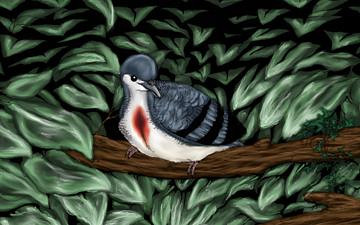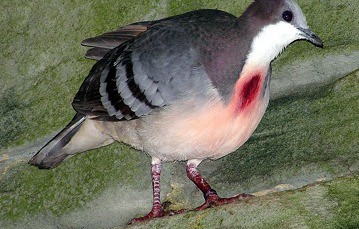The Luzon Bleeding-heart (Gallicolumba luzonica) is one of a number of species of ground dove in the genus Gallicolumba that are called “bleeding-hearts”. They get this name from a splash of vivid red colour at the centre of their white breasts. The Luzon Bleeding-heart is the species in which this feature is most pronounced, and on first sight it is hard to believe that the bird has not recently been wounded. This is also partially due to a reddish hue extending down the belly, providing the illusion of blood having run down the bird’s front.
The species is endemic to the central and southern parts of the large island of Luzon, and the neighbouring small Polillo Islands, in the Philippines. It lives in primary or secondary forest, and can be found at altitudes varying from sea level up to 1400 metres. They eat seeds, berries and grubs. They are shy and secretive, and very quiet, and rarely leave the ground except when nesting. Unlike the other bleeding-hearts, they usually lay two eggs in each clutch.
(From Wikipedia, 14 May 2011)
—
Gallicolumba luzonica has a characteristic dark red patch on its breast that looks like a bleeding wound. Short tailed and long legged; these exclusively terrestrial birds have light blue-gray wings and heads with blackish bills. The wing coverts are marked with three dark red-brown bands. Their throat, breast and under parts are white, lighter pink feathers surround the red patch on the breast. Their legs and feet are red. These birds are not sexually dimorphic and the sexes are difficult to tell apart.
The calls of G. luzonica are a single coooooo, raising in pitch only slightly in the middle of the call. Typically these birds are incredibly secretive and nearly silent. Males use a soft co-co-cooooo during courtship to attract females. Males also attract females with courtship displays. The male chases the female displaying an inflated breast to fully show his vivid blood markings or “heart”. (Naether, 1973; The Chaffee Zoo, Date Unknown)
Gallicolumba luzonica inhabits lowland forest and spends the majority of its time on the forest floor feeding. These birds roost and nest in low to medium height trees, shrubbery and vines. They use the thick surrounding undergrowth to escape from predators. They can be found from sea level to elevations of 1400 m. (del Hoyo, Elliott, and Sargatal, 1997)
Habitat Regions: Tropical; Terrestrial
Terrestrial Biomes: Forest
In their natural habitat, these terrestrial birds feed primarily on seeds, fallen berries and a variety of insects and worms found on the forest floor. In captivity, the birds may be fed oilseeds, vegetables and cheese for added nutrients when a pair is breeding. (Grzimek, 1972; The Chaffee Zoo, Date Unknown)
Animal Foods: Insects; Terrestrial Worms
Plant Foods: Seeds, grains, and nuts; Fruit
In captivity these birds are monogamous and maintain a strong bond, usually pairing for life. During breeding, males attract females with courtship displays. The male chases the female displaying an inflated breast to fully show his vivid blood markings or “heart”. Once the female is smitten, the male bows his head and coos lovingly to his intended mate. (Naether, 1973; The Chaffee Zoo, Date Unknown)
Mating System: Monogamous
It has proven difficult to observe these shy birds in their natural habitat, hence little is known about their reproductive behaviors outside of captivity. It is presumed that nesting most likely occurs during mid-May when other subspecies of the same genus nest on nearby Philippine islands. In captivity, breeding pairs can mate year-round. Females lay 2 creamy white eggs. Both parents incubate the eggs for 15 to 17 days; the cock sits on the eggs during the day and the hen sits on them at night. Although the young leave the nest after 10 to 14 days, parents continue to feed the fledglings for up to one month. At 2 to 3 months the young begin to develop adult plumage and must be separated from the parents. If this does not occur, parents will attack and sometimes kill their young.
(From EOL, 14 May 2011)





